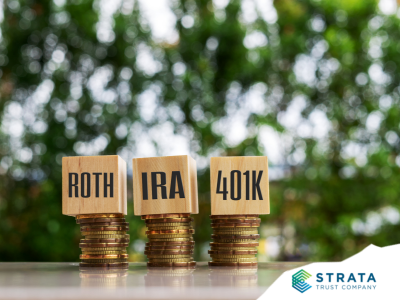Article originally published on TheStreet – Investors are seeking ways to augment their retirement savings that don’t rely on the stock market — and are finding a fit with rental portfolios in self-directed IRAs.
Headlines are filled with stories about how savers and investors have been left scrambling for portfolio income as interest rates languish near historically low levels. At a time when the biggest demographic group in American history is rolling into retirement, the pressure to find creative investment solutions for the ever-present income demand continues to weigh on aspiring retirees.
The conventional options for allocating your retirement savings remain. Within traditional individual retirement accounts, investor options include stocks, bonds, mutual funds, and even annuities. Since equity income and yields from bonds haven’t been robust enough for investors to piece together a full retirement income solution, looking beyond publicly traded securities may be the answer. This is where nontraditional investments can make sense if your IRA is set up to handle them. To that end, there is an increasing number of hopeful retirees who have made rental properties a part of their investing mix.
Benefits of Rental Income in Retirement
The real benefit of leveraging real estate, and more specifically rental property, in retirement savings accounts is the consistent cash flow these investments can produce. Stocks, bonds, and mutual funds generate cash flow but can’t be relied on to regularly deliver the same returns, particularly as the underlying value of the securities can be volatile.
A rental property, however, can deliver consistent monthly income that the owner is able to rely on thanks to lease agreements with tenants. In my experience, clients who are in or close to retirement have been able to use their rental income to support the distributions they take out and can live off this income.
Another important benefit to real estate investing is that it’s a diversification play out of the public market. Stocks and other securities can fluctuate in value on a daily and weekly basis. Unfortunately, many investors close to retirement age aren’t able to make up losses if the timing of withdrawals coincides with periods where their investments are on a downswing. With rental income, the retiree or pre-retiree can control exactly what is going into their IRA. This increases the cash-flow probability, meaning there would be more money coming into the IRA monthly than going out.
Real estate can also offer a strong return on investment (ROI). According to the S&P 500 index, the average ROI is about 10.6% for residential rental properties and 9.5% for commercial real estate properties. This is partly because real estate typically appreciates over time. Not only does the owner make monthly income due to rental payments, but they are also likely to profit when the time comes to sell.
Owning real estate and rental properties within an IRA isn’t without risk, but that risk is not much different from doing so outside of an IRA. In both cases, the possibility exists that the renter will damage the property. For this reason, it’s recommended that the IRA owner carry liability insurance on the property. The policy needs to be in the name of the IRA as the named insured rather than the IRA owner personally. The need to evict may also become an issue but partnering with a property manager will mostly relieve the owner of that responsibility.
For retirees or pre-retirees, the biggest hurdle is the relative illiquidity of real estate. While stocks or mutual funds can be sold within a few days, selling a piece of real estate usually takes a minimum of 30 days due to the process of listing, finding a buyer and settling on a contract. In today’s environment, real estate tends to sell fairly quickly, but a retiree could still find themselves in a situation where they need liquidity sooner than they can access it. When considering real estate as an IRA investment, an IRA owner may want to keep enough liquid assets available as part of a diversified portfolio.
Knowing if It’s Right
Obviously, real estate is best for investors who have enough wealth accumulated to afford the cost of purchasing a property. The more capital an investor has in their retirement savings, the more they should consider different ways of investing to reduce their risk exposure in a market downturn. Real estate is a non-correlated investment, meaning it doesn’t fluctuate with the public equity market. Investing outside the stock market is a potential strategy that offers investors greater control over retirement planning, and real estate provides the opportunity for consistent income.
Real estate has to be a good fit for the investor and their IRA, and it may not be a viable option for all retirees or pre-retirees. It’s important to be knowledgeable about the real estate market before considering owning a property inside an IRA. Investors should always do their research and understand what market values are, so they can be informed about whether a piece of property is a good investment.
If someone is interested in investing in real estate, there are avenues to gain exposure to the market without buying a property. However, if an investor wants to own a rental property in their IRA, it’s important to discuss that course of action with real estate experts, partner with a professional property manager, and include a financial professional, attorney or tax advisor in the discussion. Having a professional team that helps manage IRS regulations, general upkeep and daily tasks related to the property can help streamline holding real estate in an IRA, while exposing the IRA to the obvious perks of consistent monthly rental income.
Three Ways to Invest in Real Estate
Generally speaking, there are three main ways to gain exposure to real estate in an IRA. The first option would be a publicly-traded real estate investment trust (REIT). This is a company that invests in many properties intended to make a profit, and typically mass real estate projects. A REIT functions similarly to a mutual fund. It can be bought and sold daily and held in any traditional IRA, or an SDIRA, but it’s tied to real estate instead of public companies. With REITs, the investor isn’t involved in property management and may not even know what properties they are investing in.
The next option is a private real estate fund, which is similar to a REIT but on a much smaller level. These funds are privately owned, and normally include a small number of investors in the purchase of a commercial center or apartment complex. Normally, private real estate funds are reserved only for high-net-worth individuals who can contribute a large amount of capital and sometimes take on a limited partner role. The owners of the fund may even interview potential investors and add them one at a time, rather than selling shares on a continuous basis.
The third approach is direct real estate acquisition, in which the investor is buying a full property that is owned within the IRA and has a deed to reflect ownership. The only type of IRA that can hold direct ownership of property is a self-directed IRA (SDIRA). The IRS has created rules dictating how properties owned with an SDIRA can be purchased and used. First, the property must be held strictly for investment purposes. Neither the account holder nor any of their direct relatives can utilize or benefit from the property (outside of the rental income going into the IRA), so it can’t be a second or vacation home.
Additionally, the property cannot be bought from a “disqualified” person (e.g., a spouse, parents, grandparents, children or IRA service providers). This could also include an IRA fiduciary or anyone who has control over the investor’s assets. An IRA owner should consult with a legal or tax advisor to help navigate the prohibited transaction rules.
Direct ownership of real estate within an IRA is a popular option for investors who can afford to buy a property because it’s an asset that can be leveraged and all the returns and rental income go straight into the owner’s IRA. The owner also has complete control of the property, allowing them to make all decisions regarding it, including when to sell. However, the owner also has to ensure they are partnered with a professional for property management and must make decisions about repairs and upkeep. An informed SDIRA custodian can expand on these details around property management, and the IRS rules that property owners are required to follow in the management of real estate assets held by IRAs.
Each option to gain real estate exposure in an IRA has its positives and negatives. REITs and private funds provide that diversification without as many potential headaches, but their returns could be less. Direct real estate ownership is a bit more involved and time-consuming but could offer steady income and strong ROI.
Owning a Property in a Self-Directed IRA
SDIRAs are for sophisticated investors who want complete control over what their IRA holds. The owner of the SDIRA makes every decision as to what they invest in and can customize their retirement savings. SDIRA holders use a custodian that will process the investments, but does not provide advice or participate in the decision-making process about what to invest in. The holder is truly the self in a self-directed IRA.
This control appeals to many savvy and experienced investors who seek increased diversification, as SDIRAs open the door to basically any asset class they might want to access beyond traditional stocks, bonds and ETFs, including real estate, private equity, private debt and precious metals. Just like real estate isn’t for every pre-retiree or retiree, though, neither are SDIRAs. They require more involvement and management than traditional IRAs. But if an investor is knowledgeable about the markets and wants increased control over their retirement savings, self-directed IRAs can be a great option.
Because the potential consistency of rental income going into the account is extremely beneficial in setting investors up for successful retirement, it could be worth the extra effort to connect with knowledgeable professionals, learn about the real estate market, and weigh the benefits and viability of owning property inside of an SDIRA.
The information provided in this article is educational content and not investment, tax or financial advice. You should consult with a licensed professional for advice concerning your specific situation.
About the Author: Patrick Hagen
Patrick Hagen is the national director of business development at STRATA Trust Company. He has more than 17 years of professional experience with SDIRAs. Through his work, he helps to educate investors and financial advisors, raising awareness of SDIRAs and alternative investments. If your interested in learning more about self-directed IRAs connect with us today!















